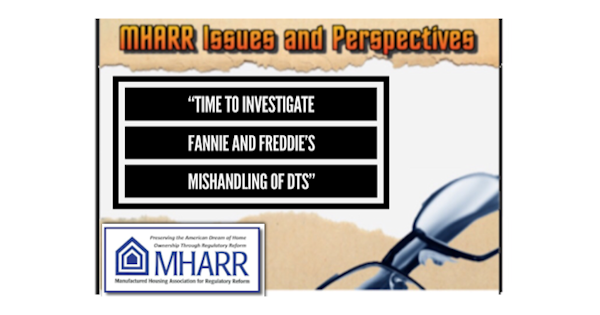It’s been more than ten years since Congress enacted the Housing and Economic Recovery Act of 2008 (HERA) and its “Duty to Serve Underserved Markets” (DTS) mandate. DTS directs both Fannie Mae and Freddie Mac to “develop loan products and flexible underwriting guidelines to facilitate a secondary market for mortgages on manufactured homes for very low, low and moderate-income families.” Insofar as it expressly authorizes programs for both real estate and personal property (chattel) manufactured housing consumer loans, DTS was – and always has been – aimed at increasing the availability (and lowering the cost) of purchase-money financing for mainstream, affordable manufactured homes by providing securitization support for lenders, which would lower their credit risk, while promoting greater market competition, which would also result in lower borrowing costs for consumers. That laudable objective, however, has not been achieved, and with the industry now in an eight-month sustained production decline, DTS remains a nearly empty shell, leaving the 80% of the manufactured housing consumer finance market that relies on personal property loans totally unserved, while scarce – and badly needed – DTS resources are diverted to programs that do nothing for mainstream manufactured housing consumers, but dobenefit a handful of the industry’s largest corporate conglomerates. This “hijacking” of DTS, with the knowledge and support of both Fannie Mae and Freddie Mac, deserves a thorough investigation by Congress and full accountability for those involved.
Put simply, DTS was never designed to be a corporate welfare program for the industry’s largest conglomerates. But that is exactly what it’s becoming, as a result of its botched implementation by Fannie Mae and Freddie Mac (with a “wink and a nod” from their federal regulator, the Federal Housing Finance Agency – FHFA), and its diversion away from the mainstream, affordable manufactured homes produced by all HUD Code industry manufacturers, in favor of high-dollar, hybrid-type homes that are produced by only one or, at most, just a handful of manufacturers. As usual, the winners in this fiasco (thus far) are certain well-heeled, well-connected industry conglomerates that play to the pre-existing prejudices of Fannie and Freddie, while the “losers” are the rest of the HUD Code industry and the millions of lower and moderate-income American families that could otherwise be helped by DTS to purchase and own a home of their own.
The factual analysis leading to these conclusions is, in actuality, simple, straightforward and fundamentally undisputed. Start with a basic undisputed fact, as confirmed by federal government data. That is — as shown by U.S. Census Bureau housing market data — that some 76% of all HUD Code manufactured housing placements in 2017 (the most recent year for which such data is available), were titled as personal property (i.e., chattel). While not necessarily representing a one hundred-percent direct correlation, this data effectively means that something close to three-quarters of the manufactured homes purchased in 2017 were financed as personal property, while only 17% of all manufactured homes that year were titled – and presumably purchased and financed – as real property. This division between personal property-based placement and financing on the one hand, and real estate-based placement and financing on the other, has remained relatively constant in recent years, moreover, with the proportion of personal property placements varying between 76% and 80%, while real estate placements varied between 13% and 17%. Thus, there can be no actual or legitimate dispute that the vast bulk of the manufactured homes purchased by lower and moderate-income American families, are served by personal property-based chattel financing.
Nor is this – or should this — be a surprise to anyone. While manufactured housing personal property loans generally carry a higher interest rate than real estate-based loans, due, in part, to the absence of land as security for the lender, personal property loans, using the home itself as the sole security for the lender, cost less overall than real estate loans which include the purchase cost of the land underlying the home. As a result, personal property loans have tended to be favored by lower and moderate-income consumers, including consumers who might otherwise be unable to afford a home of their own. That is, with an average sales price of $48,300.00 without land (in 2017) a single-section manufactured home would cost far less to purchase and finance than either an average site-built home with land (with an average combined sales price of $384,900.00) ora single-section manufactured home with land, which, according to the same data, could add something on the order of $90,000.00 to the structural price of the home itself. Consequently, even with higher borrowing costs for chattel loans (resulting from higher interest rates), such loans on HUD Code manufactured homes nevertheless represent – and have always represented – the most affordable route to homeownership for any American anywhere in the United States.
Given this basic, undisputed data, the most direct route to fulfilling the promise and mandate of DTS – i.e., putting more lower and moderate-income American families into homes that they can truly and legitimately afford – would be for Fannie Mae and Freddie Mac to provide market-significant securitization and secondary market support for the manufactured housing personal property consumer lending market, as MHARR has always maintained. This is where the vast majority of manufactured housing purchasers are, and where the vast majority of lower and moderate-income manufactured housing purchasers are. And, not to overstate the point, these are the very people that Fannie and Freddie should be serving and, in fact, were created to serve, and are directed to serve by their respective charters and authorizing legislation.
But Fannie Mae and Freddie Mac have no interest in serving the type of housing consumers served by mainstream manufactured housing. Thus, they have no interest in providing securitization and secondary market support for mainstream, chattel-financed manufactured housing. If they did have such an interest, and had been serving the mainstream manufactured housing market all along, DTS would not have been necessary and would not have been enacted by Congress. What need would there be for a remedy – such as DTS — if there was no problem to begin with? Conversely, the fact that Congress felt the need to enact a remedy shows that there was, in fact, a problem with Fannie and Freddie’s treatment of manufactured housing consumers. But Fannie Mae and Freddie Mac, aided by FHFA and some within the industry, have worked overtime to circumvent that remedy, while they continue to discriminate against lower and moderate-income manufactured American families that seek to purchase a truly affordable, mainstream manufactured home. At the same time, Fannie and Freddie talkabout support for the mainstream manufactured housing market while, in fact, doing no such thing.
How do we know this? Again, “facts are stubborn things.” To start with, the reality is that neither Fannie Mae nor Freddie Mac has yet to implement even a “pilot program” for manufactured home chattel loans, some 11 years after the enactment of DTS. A May 23, 2019 letter from Fannie Mae Vice President Jonathon Lawless to MHARR thus refers only to a “potential” manufactured housing personal property “pilot” program. And forget any kind of market-significant support for the predominate type of manufactured home consumer lending in the United States. In fact, according to sources, Fannie and Freddie have yet to provide market support for anymanufactured home consumer personal property loans under DTS – a point effectively confirmed by Mr. Lawless, whose May 2019 letter states that Fannie Mae’s DTS Plan “has never called for [the] immediate purchase and securitization of these [personal property] loans.”
And what are Fannie Mae and Freddie Mac doing instead? Rather than providing the type of market support that is desperately needed to expand the availability and affordability of mainstream manufactured homes for lower and moderate-income purchasers – what they should be doing under DTS – Fannie and Freddie instead, are offering support for the types of “manufactured homes” that theywant to see and promote; not mainstream, affordable, HUD Code manufactured homes, but “manufactured homes” that are more like the far more costly site-built homes that Fannie and Freddie are accustomed to dealing with. Thus, in a January 14, 2019 article entitled “Delivering on Our Affordable Housing Mission Under Duty to Serve” (and there are manymore such examples), Fannie Mae Executive Vice President Jeffrey Hayward refers to “manufactured homes” constructed in accordance with Fannie’s “MH Advantage” program – for manufactured homes titled as real estate (not chattel) – as being “similar to site-built homes.” And, of course, this is – and remains – Fannie and Freddie’s central criterion in providing support for “manufactured homes” – i.e., they cannot be mainstream (and therefore affordable) manufactured homes but, instead, must be “similar to [the] site-built homes” that Fannie and Freddie are used to dealing with, and thus are within their pre-existing “comfort zone.”
It’s the same thing with the so-called “new class” of manufactured homes. These homes are described (and specified) as being more like site-built homes – or a hybrid between site-built homes and manufactured homes. As a result, they are projected to cost significantly more than an “average” mainstream manufactured home – up to approximately $220,000.00 as compared with an “average” (2017) price of $71,900.00 for all mainstream manufactured homes (i.e., both single and multi-section) — and are simply not the type of affordable, non-subsidized affordable housing resource that is provided by mainstream manufactured housing; meaning, again, that they would appeal – and be marketed to – the more “upscale” consumers that Fannie and Freddie would prefer to deal with.
And just as long as we’re on the subject, what type of loan performance data exits to support the creation of a special program for this supposed “new class” of manufactured home (or “MH Advantage” homes for that matter)? For more than a decade, Fannie and Freddie have refused to provide anytype of DTS support for mainstream manufactured housing personal property loans, citing a lack of “performance data” to justify entry into that market. So, if the availability of “performance data” is thus a prerequisite for market support from Fannie and Freddie under DTS, what type of “performance data” do Fannie or Freddie have for an entirely “new class” of home?
Assuming that the meaning of “new” hasn’t changed recently, “new” means “not done before.” And, if “new” still means “new,” then it also means, by definition, that there is nopre-existing loan performance data for that “new” class of home – because it’s … well … “new.” So, for the 80% of the existing, mainstream manufactured housing market financed through chattel loans, no performance data means no DTS support. It means not even a measly “pilot program” after 11 years. But for a “new” class of higher-cost home, being pursued by just a few of the industry’s largest conglomerates (if that many), no performance data means a ticket to instant Fannie and Freddie support – even though there is not one word about a “new class” of manufactured homes or a pilot program for a “new class” of manufactured homes in the DTS implementation plans filed by Fannie and Freddie and approved by FHFA in 2018. And all of this comes to you courtesy of the same people who nearly crashed the world economy by backstopping trillions of dollars in “subprime” loans on homes that borrowers could not legitimately afford.
The reality is that DTS is in the process of being “hijacked” by special interests. It is being diverted from its primary, essential and crucial mission with regard to manufactured housing – to expand the availability of consumer loans for mainstream manufactured housing; to bring more lenders into the market; and to lower the (interest) cost of mainstream manufactured home consumer loans through increased competition and risk reduction for lenders. Fannie and Freddie’s treatment and botched implementation of DTS is an ongoing farce for the industry and an ongoing tragedy for lower and moderate-income Americans who simply wish to purchase a home of their own, but continue to be subjected to flat-out discrimination, in open defiance of Congress and with a knowing, and apparently intentional pass from FHFA. The time has come, therefore, for Congress to re-involve itself in this matter, to conduct a thorough and probing investigation of DTS with respect to manufactured housing, and see to it that the DTS directive is enforced and implemented now, not “honored” in the breach.
Mark Weiss
MHARR is a Washington, D.C.-based national trade association representing the views and interests of independent producers of federally-regulated manufactured housing.
“MHARR-Issues and Perspectives” is available for re-publication in full (i.e., without alteration or substantive modification) without further permission and with proper attribution to MHARR
Time to Investigate Fannie And Freddie’s Mishandling Of DTS-pdf














